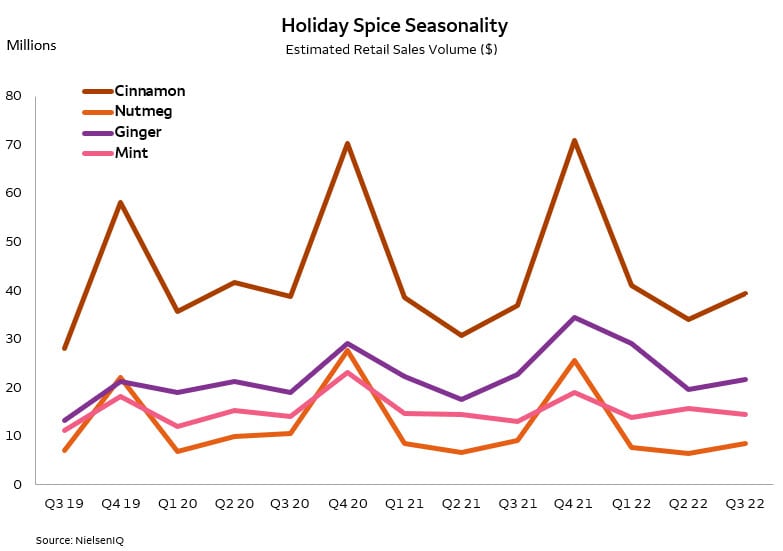By David Branch, Wells Fargo Food and Agribusiness Sector Analyst, Aquaculture, Greenhouses, Nurseries, Seafood, Sugar
 Just as quickly as it began, the year is coming to an end. Fall décor has been replaced with holiday adornments, pumpkin spice lattes have been replaced by mint-flavored beverages and eggnog, and our favorite holiday tunes can be heard on every street corner. Part of what makes the season special is the distinctive aromas of spices such as cinnamon, ginger, and peppermint. Childhood memories of aromas swirling through my grandmother’s home always come back to me this time of year.
Just as quickly as it began, the year is coming to an end. Fall décor has been replaced with holiday adornments, pumpkin spice lattes have been replaced by mint-flavored beverages and eggnog, and our favorite holiday tunes can be heard on every street corner. Part of what makes the season special is the distinctive aromas of spices such as cinnamon, ginger, and peppermint. Childhood memories of aromas swirling through my grandmother’s home always come back to me this time of year.
Baking seasonal cookies, cakes, and sweet breads remains a tradition for many people. In fact, data shows certain spice purchases spike around the holidays. As the sugar analyst for Wells Fargo’s Food & Agribusiness team, I study how consumers use the many products in the grocery store spice aisle. Did you know that most of these delectable spices and flavorings are derived from plants and their origins can be traced back thousands of years? Let’s dive into a little history behind some of our favorite spices. Snickerdoodles, anyone?

Peppermint, please: Peppermint (Mentha piperita), native to the Middle East and Europe, is the number one flavoring for non-chocolate hard candies and a quintessential herb for the holiday season. Peppermint has a long history and has been referenced in ancient Egyptian medical texts as early as 1550 B.C. As a cross between watermint and spearmint, peppermint has a higher menthol concentration which produces the cooling sensation in your mouth. Today, 70% of peppermint’s global production comes from the U.S. and 84% of that can be found in Oregon, Washington, and Idaho. In 2021, due to supply chain issues and a weak mint harvest, many experienced the “Candy Cane Crisis.” This year, candy canes are back on shelves and the minty flavoring we love in our lattes and teas will never wane.
In a nutshell: Synonymous with eggnog and other seasonal fare, nutmeg comes from the seed of Myristica fragrans, a tropical evergreen tree native to the Spice Islands of Indonesia. Portuguese explorers (and later the Dutch) found nutmeg trees on the islands and dominated the trade of this precious spice by preventing living plants or viable seeds from being exported. The seed of Myristica fragrans produces two important spices – Nutmeg and Mace. Nutmeg is derived from the tree’s actual seed which is egg-shaped and is produced by drying and grinding the seed kernels into powder. Mace is derived from the waxy, lacy sheath encasing the nutmeg seed (the arillus) and its flavor is considered lighter than that of nutmeg. However, nutmeg is considered the sweeter of the two spices.
Cinna-win: Probably the oldest and most sought-after spice throughout history is cinnamon. Nielsen data shows a significant spike in retail sales volume in the fourth quarter in recent years donning this spice as a true holiday staple. However, there’s a difference between true cinnamon and what we purchase in the store. True cinnamon is derived from the aromatic inner bark of Cinnamomum verum, a small, bushy tree native to Sri Lanka and is known as Ceylon cinnamon. In North America, the most common spice labeled and sold as cinnamon is cassia, also known as “Chinese cinnamon” which is harvested from the bark of trees related to C verum and native to southern China and south Asia. Cassia is cheaper to produce and has a bolder, less subtle flavor than true cinnamon. In comparison, Ceylon cinnamon has a delicate, nuanced flavor that works well in sweet and savory foods and drinks. It has a paler color than cassia and is comprised of many thin layers of bark rather than a single coiled strip of bark and is also softer in texture. Nonetheless, cinnamon’s warm and pungent aroma continues to make this spice a go-to for treats every year.
Oh, gingersnap!: Gingerbread houses seem to get more elaborate, and although we associate cookies and beverages with ginger, the Chinese and Indians are believed to have originally produced ginger as a tonic root to treat ailments for more than 5,000 years. Perhaps you have received advice from a parent or grandparent to eat ginger for an upset stomach? Queen Elizabeth I of England is credited with the invention of the gingerbread man. In fact, ginger became so popular that it was kept at pubs and inns for patrons to sprinkle into their beer, while stirring with a hot poker – the invention of ginger ale. Data from 2015 indicates 5%-10% of adults in the U.S. use botanical supplements, such as spices, for health benefits. And, the 2020-2025 U.S. Dietary Guidelines for Americans state that spices and herbs can help flavor foods while reducing added sugars, saturated fat, and sodium, while also increasing the enjoyment of nutrient-dense foods that reflect specific cultures.
I’ll leave you with this. It’s said that festive drinks that mix dairy products with alcohol, like eggnog, once signaled wealth and prosperity. As we celebrate the close of 2022, my wish for you is a 2023 filled with success for you and your loved ones.
Happy Holidays!
 David Branch is a Sector Manager within the Wells Fargo Agri-Food Institute focused on seafood/aquaculture, nursery/greenhouse, sugar, and other specialty crops.
David Branch is a Sector Manager within the Wells Fargo Agri-Food Institute focused on seafood/aquaculture, nursery/greenhouse, sugar, and other specialty crops.
David possesses greater than 30 years of lending experience. Prior to joining Wells Fargo, he worked for the Bond & Corporate Finance Group at John Hancock Financial Services where he was responsible for originating and servicing loans and private equity investments in the forest products, building materials, timber, and paper industries throughout the US, Canada, Europe, South America, and the Pacific Rim. Previously, he worked at Travelers Insurance Company and CoBank.
David graduated from Louisiana Tech University with a Bachelor of Science. in Forestry and earned a Master of Science in Forest Economics from Louisiana State University. David currently serves on the board of The Frank Norris Foundation, a non-profit foundation that publishes the Timber-Mart South© quarterly newsletter and price reports.

 Sign On
Sign On 